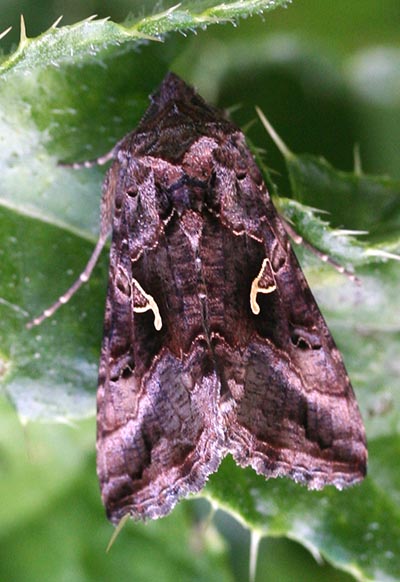 |
| Silver-Y moth |
Silver Y moths are usually immigrant, although some breeding is known. Survival over winter is unlikely, so most specimens will be found after a warm southerly wind, just like we had on Tuesday and Wednesday.
Since I had my camera in hand, I had a quick look at the hoverflies and bumblebees that were busy pollinating my courgettes and I spotted movement on my broccoli leaves:
A quick glance told me that she was an Ichneumonid of some kind, and it was clear that she was investigating the larvae of the Large White butterfly under the leaves. She was moving at an incredible speed, scurrying over and under leaves, often disappearing completely from view.
 |
| The Ichneumon wasp Hepiopelmus variegatorius |
 |
| The Ichneumon wasp Hepiopelmus variegatorius |
 |
| The Ichneumon wasp Hepiopelmus variegatorius |
 |
| The Ichneumon wasp Hepiopelmus variegatorius under a leaf |
I 'massaged' that shot in the photo editing program and found that she was getting very close to the larvae (which can just be seen at the top of this shot):
 |
| The Ichneumon wasp Hepiopelmus variegatorius investigating a larva of the Large White butterfly |
My next task was to try to get an identification, and I first turned to a list of known parasitoids of the Large White butterfly. The Large White has been very extensively studied, since it is seen as a pest species for crops, and methods of control are always being sought. A fairly quick search (perhaps 2 hours) revealed nothing like a match, so I went to the references (the most recent one is 1960!) and searched for identification via that unusual crescent on her thorax. Still no luck.
I decided to 'phone a friend' and NHM London in the guise of Gavin Broad came up with Hepiopelmus variegatorius, which fortunately is one of the few Ichneumons that can be accurately identified from a photograph. These are known to parasitise the larvae of Spilosoma sp. (Ermine Moths), so the Large White larvae were safe in this particular instance.
Back to the reference, to find that Hepiopelmus variegatus is described as rare in the UK, and a quick search of the Irish national database revealed no previous records for Ireland. So this seems to be a first Irish record (confirmed 16/09/2013).
If I hadn't seen the Silver Y, then I wouldn't have had my camera to hand, and that record would still not exist.
1508 Species, now.
If I hadn't seen the Silver Y, then I wouldn't have had my camera to hand, and that record would still not exist.
1508 Species, now.
3 comments:
Did you still find something to cook in the garden after all that mothery?
I like the sound of your mustard sauce - how do I make it - I have plenty of pork shops in the freezer.
Incredible photos, Stuart - and it just shows what you can find if you look carefully.
Weaver, you must have a very large freezer :-)
Sorry about the spelling mistake - very funny joke though!
This is my first Ian Rankin. He was recommended to me. The one I have read is 'Set in Darkness'. I usually like novels which are mainly in prose so didn't think I would enjoy this with so much dialogue, but I really enjoyed it. What interests me is how he manages to keep each character in character so to speak, so that by the end of the novel you can almost anticipate what reaction you are going to get. Also I liked the ending where the 'baddie' remains free to act again although we - and Rebus - know he is guilty. Shall certainly look for more.
I tried to get on to your site to leave a comment but it is all too complicated for me I am afraid.
Post a Comment